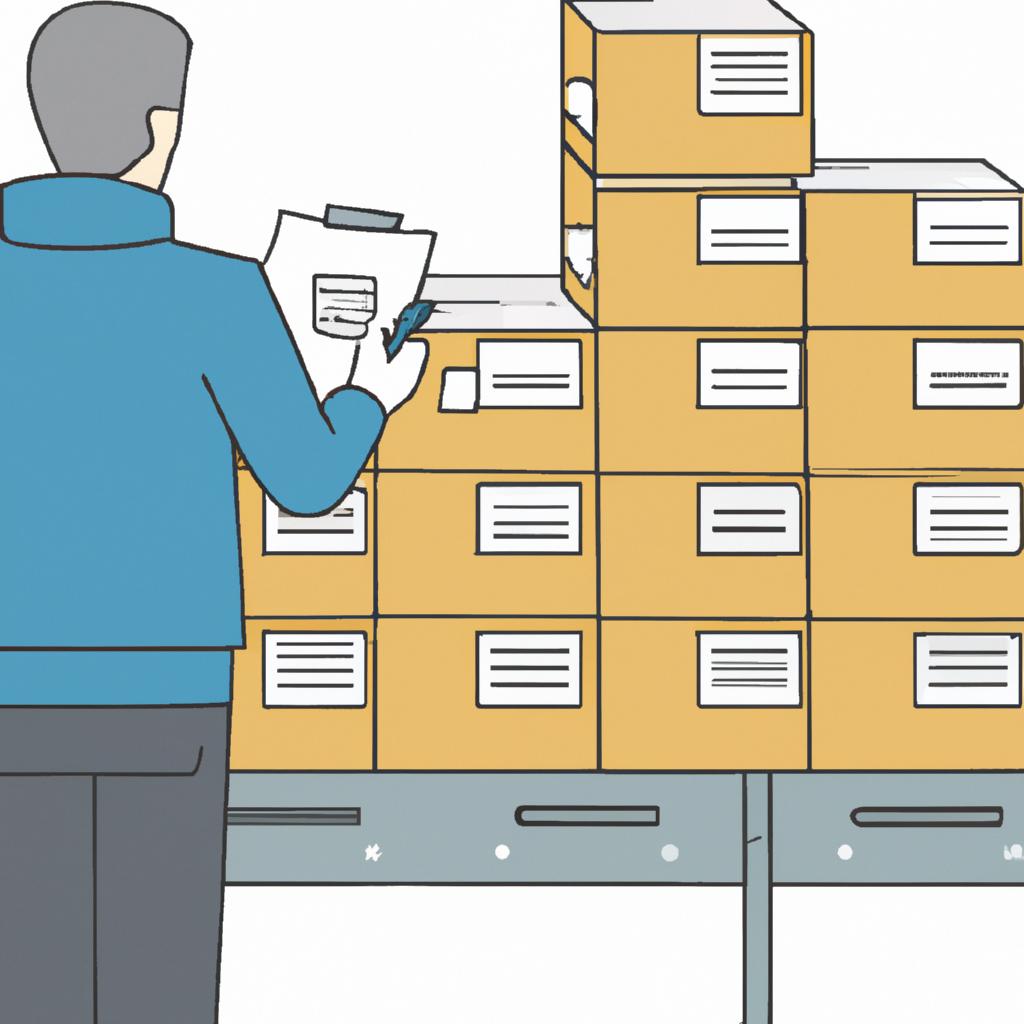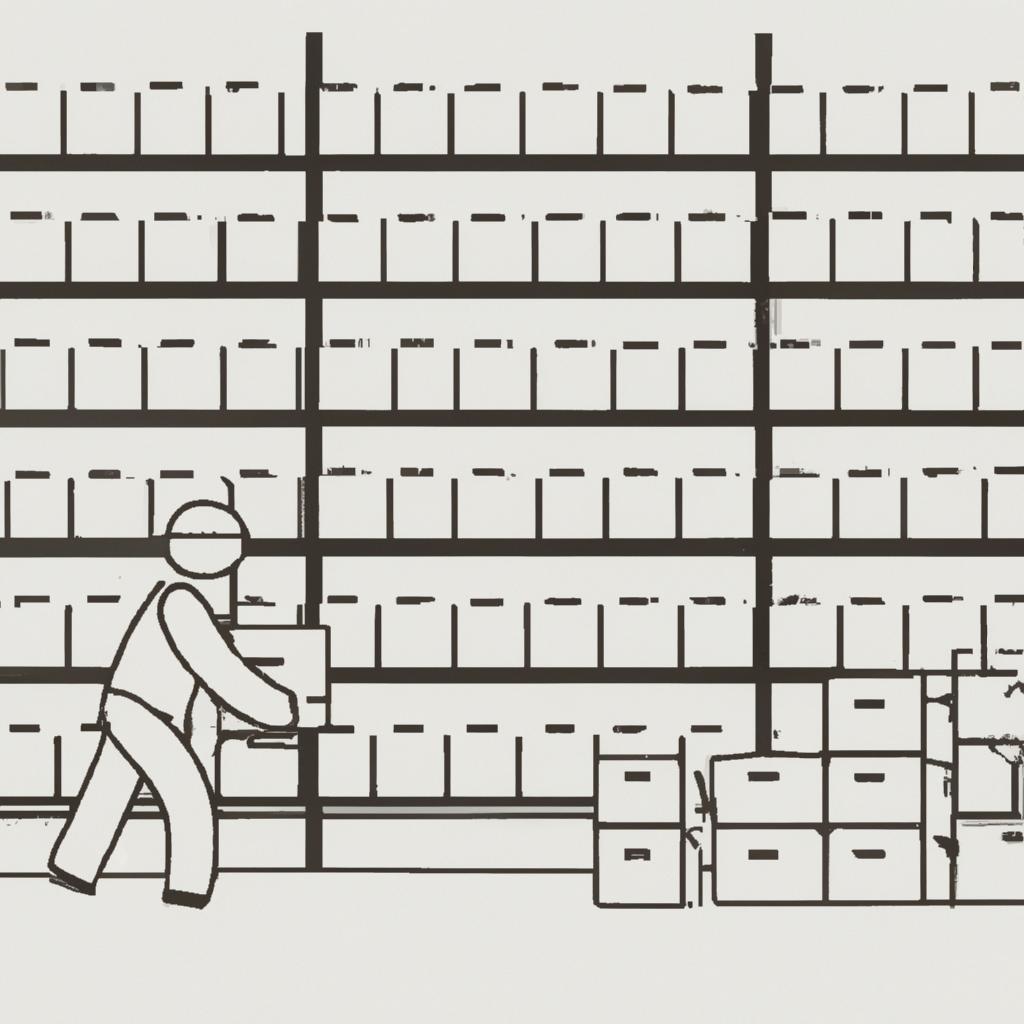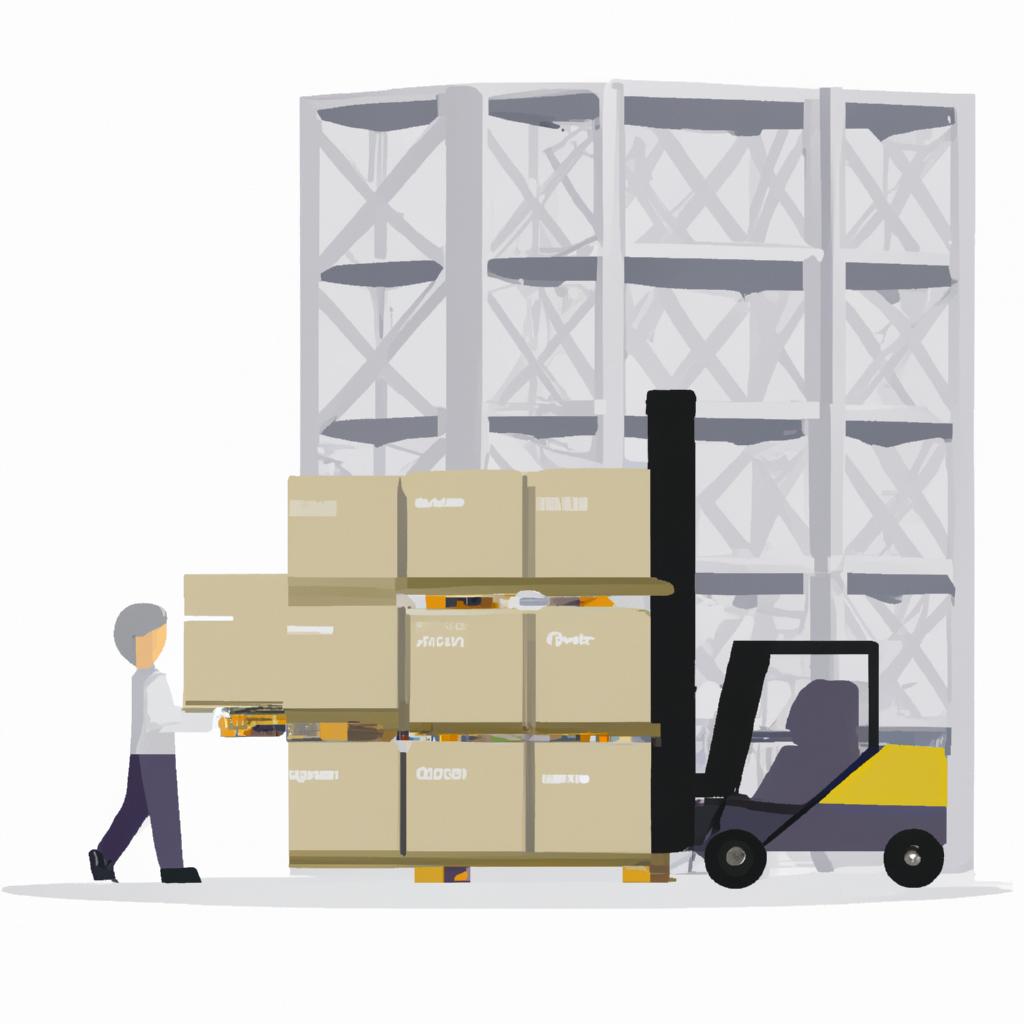Tracking and Tracing in Transportation and Logistics: A Guide for Freight Forwarding

In the world of transportation and logistics, efficient tracking and tracing systems play a pivotal role in ensuring the smooth movement of goods across various supply chains. Whether it be delivering perishable items to grocery stores or transporting high-value products internationally, effective tracking and tracing technologies have become indispensable for freight forwarding companies. For instance, imagine a scenario where a pharmaceutical company needs to transport a batch of vaccines that require strict temperature control throughout their journey. Without an accurate tracking system in place, it would not only be challenging but also risky to ensure that these vaccines maintain their integrity and potency during transit.
This article aims to provide a comprehensive guide on tracking and tracing in transportation and logistics specifically tailored towards freight forwarding operations. By exploring the importance, benefits, and challenges associated with implementing such systems, this guide will equip professionals in the industry with valuable insights to enhance their logistical processes. Furthermore, through analyzing real-life examples and case studies from successful implementation scenarios, readers can gain practical knowledge on how different tracking and tracing solutions have been utilized effectively within diverse contexts.
Overview of Tracking and Tracing in Transportation and Logistics
Overview of Tracking and Tracing in Transportation and Logistics
Imagine a scenario where a company orders a shipment of perishable goods from overseas. The customer eagerly awaits the delivery, expecting the items to arrive on time for an important event. However, as days pass with no sign of the package, frustration mounts. This situation could have been avoided through effective tracking and tracing in transportation and logistics.
Tracking and tracing refer to the process of monitoring shipments throughout their journey, from origin to destination. It provides real-time visibility into the movement and status of freight, allowing stakeholders to proactively address any issues that may arise during transit. With the advancements in technology, companies now have access to various tools such as GPS tracking systems, barcoding, RFID tags, and digital platforms that facilitate seamless tracking and tracing processes.
The benefits of implementing robust tracking and tracing mechanisms are numerous:
- Enhanced Efficiency: By closely monitoring shipments at each stage of transportation, delays or disruptions can be quickly identified and rectified. This proactive approach minimizes downtime, reduces costs associated with inefficiencies, and ensures timely deliveries.
- Improved Customer Satisfaction: Real-time updates on shipment progress enable businesses to provide accurate information to customers regarding estimated arrival times. Meeting promised delivery schedules enhances trust between organizations and their clients.
- Mitigation of Risks: Tracking and tracing allow for early detection of potential risks such as theft or damage during transit. Companies can take immediate action by alerting authorities or initiating insurance claims before significant losses occur.
- Streamlined Supply Chain Operations: Transparency provided by tracking and tracing enables better coordination among all parties involved in the supply chain – manufacturers, transporters, warehouses, distributors – resulting in smoother operations overall.
| Enhanced Efficiency | Improved Customer Satisfaction | Mitigation of Risks | |
|---|---|---|---|
| 1 | Minimizes downtime | Accurate information for customers | Early detection of risks |
| 2 | Reduces costs | Enhances trust between organizations | Prompt action |
| 3 | Ensures timely deliveries | ||
| 4 |
In summary, tracking and tracing play a vital role in transportation and logistics by providing real-time visibility into the movement and status of shipments. The benefits include enhanced efficiency, improved customer satisfaction, risk mitigation, and streamlined supply chain operations. In the subsequent section, we will delve deeper into the importance of tracking and tracing for efficient supply chains.
Note: Tracking is the process of monitoring shipment progress at specific intervals or milestones during transit, whereas tracing involves following the entire journey from origin to destination. These terms are often used interchangeably but have distinct meanings in professional contexts.
[Continue Reading: The Importance of Tracking and Tracing for Efficient Supply Chains]
The Importance of Tracking and Tracing for Efficient Supply Chains
Section: The Role of Tracking and Tracing in Streamlining Supply Chains
In today’s fast-paced global marketplace, efficient supply chain management plays a pivotal role in the success of businesses. One key aspect that enables smooth operations within the transportation and logistics industry is tracking and tracing. To better understand how this process enhances supply chains, let us consider an example.
Imagine a multinational retail company that imports various products from suppliers across different countries. Without effective tracking and tracing mechanisms in place, it would be challenging for the company to monitor the movement of goods at every stage of their journey. However, by implementing robust tracking systems, such as radio frequency identification (RFID) tags or barcode scanning technologies, they can gain real-time visibility into their shipments’ locations, ensuring accurate delivery estimates and proactive response to potential delays.
There are several reasons why incorporating tracking and tracing methodologies is crucial for efficient supply chain management:
- Enhanced transparency: By utilizing sophisticated tracking technologies, companies can obtain comprehensive insights into their inventory movements. This increased transparency allows them to identify bottlenecks or inefficiencies throughout the supply chain promptly.
- Improved customer satisfaction: Real-time updates on shipment status enable businesses to provide accurate information to customers regarding expected delivery times. This not only increases trust but also enhances overall customer experience.
- Proactive issue resolution: With timely notifications about any deviations or disruptions along the supply chain, companies can proactively address issues before they escalate into significant problems.
- Data-driven decision making: Collecting data through tracking and tracing processes empowers organizations with valuable information for optimizing their supply chain strategies, identifying patterns or trends, and making informed decisions.
To further illustrate these benefits visually, we present a table showcasing some advantages associated with incorporating tracking and tracing mechanisms in transportation and logistics:
| Advantages | Description |
|---|---|
| Increased efficiency | Allows for faster order processing |
| Cost reduction | Minimizes the risk of lost or misplaced shipments |
| Inventory optimization | Enables accurate stock management and reduces overstocking |
| Enhanced security | Decreases the likelihood of theft or unauthorized access |
In conclusion, tracking and tracing play a vital role in streamlining supply chains by providing transparency, improving customer satisfaction, enabling proactive issue resolution, and facilitating data-driven decision making. In the subsequent section, we will explore key technologies and systems that enable effective tracking and tracing processes within transportation and logistics.
Next Section: Key Technologies and Systems for Tracking and Tracing
Key Technologies and Systems for Tracking and Tracing
To understand the importance of tracking and tracing in transportation and logistics, it is essential to explore the key technologies and systems that enable this process. One such technology is Radio Frequency Identification (RFID), which uses electromagnetic fields to automatically identify and track tags attached to objects. For instance, imagine a scenario where an international shipment of perishable goods needs to be transported from a farm in South America to a supermarket chain in Europe. By using RFID tags on each individual product, the freight forwarding company can monitor its location throughout the journey, ensuring timely delivery and minimizing potential losses.
The successful implementation of tracking and tracing relies on several key technologies and systems:
- Global Positioning System (GPS): GPS enables real-time monitoring of vehicles or containers during transit. This allows companies to accurately track their assets’ locations, optimize routes for efficiency, prevent theft or unauthorized use, and provide customers with accurate estimated arrival times.
- Barcodes: Barcodes are widely used as cost-effective tools for tracking items within supply chains. They contain information about products such as SKU numbers or serial numbers, facilitating inventory management and streamlining order fulfillment processes.
- Electronic Data Interchange (EDI): EDI facilitates seamless communication between different entities involved in the supply chain by standardizing electronic data exchanges. It enables quick sharing of information related to shipments, invoices, purchase orders, and more among suppliers, carriers, customs officials, and other stakeholders.
- Transportation Management Systems (TMS): TMS software provides end-to-end visibility into all aspects of transportation operations. It helps automate processes like route planning, load optimization, carrier selection, documentation generation, invoicing, and performance analytics.
These technologies form the foundation for effective tracking and tracing practices by providing reliable data capture methods and streamlined communication channels across various stages of transportation. To illustrate their impact further:
| Tracking and Tracing Benefits | Technologies and Systems |
|---|---|
| Enhanced supply chain visibility | RFID, GPS, Barcodes |
| Improved inventory accuracy | Barcodes, EDI |
| Faster response to disruptions | TMS, GPS |
In summary, the integration of key technologies and systems significantly contributes to the overall efficiency and effectiveness of tracking and tracing in transportation and logistics. By leveraging these tools, companies can optimize their supply chains, reduce costs, enhance customer satisfaction, and mitigate risks. The next section will delve into the benefits and challenges associated with implementing tracking and tracing in freight operations.
Moving forward, let us now explore the Benefits and Challenges of Implementing Tracking and Tracing in Freight Operations.
Benefits and Challenges of Implementing Tracking and Tracing in Freight Operations
Section: Benefits and Challenges of Implementing Tracking and Tracing in Freight Operations
Tracking and tracing technologies have revolutionized the transportation and logistics industry, providing numerous benefits to freight forwarding companies. By implementing these systems, businesses can improve operational efficiency, enhance customer satisfaction, mitigate risks, and gain a competitive edge in the market.
For instance, let’s consider a hypothetical scenario where a freight forwarder implements advanced tracking and tracing systems across its operations. As a result, they are able to accurately monitor the movement of goods at every stage of the supply chain. This real-time visibility allows them to proactively address any potential issues or delays that may arise during transit. Ultimately, this leads to better on-time delivery performance, improved customer service levels, and increased trust from clients.
The advantages of implementing tracking and tracing technology extend beyond just timely deliveries. Here is an emotional response-invoking bullet point list highlighting some key benefits:
- Minimized shipment loss or theft
- Enhanced transparency for customers
- Streamlined inventory management processes
- Reduced administrative burdens
Furthermore, by leveraging tracking and tracing solutions, freight forwarders can effectively manage their resources and optimize their operations. A table below shows how different stakeholders benefit from these technologies:
| Stakeholder | Benefit |
|---|---|
| Customers | Increased peace of mind knowing the location of their shipments |
| Carriers | Improved route planning leading to reduced fuel consumption |
| Warehouse Operators | Better coordination for efficient loading/unloading activities |
| Customs Authorities | Simplified inspection procedures due to accurate documentation |
Despite the numerous advantages offered by tracking and tracing systems, there are also challenges associated with implementation. These include initial setup costs, integration complexities with existing IT infrastructure, data security concerns, as well as resistance from employees who may be wary of change.
In conclusion,
As we move into discussing best practices for effective tracking and tracing in transportation in the subsequent section (Best Practices for Effective Tracking and Tracing in Transportation), it is important for freight forwarders to carefully consider the benefits and challenges associated with these technologies. By overcoming implementation hurdles and embracing tracking and tracing systems, companies can unlock significant value across their operations, leading to improved efficiency, customer satisfaction, and overall success in the dynamic world of transportation and logistics.
Best Practices for Effective Tracking and Tracing in Transportation
Section H2: Best Practices for Effective Tracking and Tracing in Transportation
Implementing effective tracking and tracing practices is crucial for ensuring efficient freight operations. By utilizing advanced technologies, such as GPS tracking systems and RFID tags, logistics providers can gain real-time visibility into the movement of goods throughout the supply chain. In this section, we will explore some best practices that can enhance tracking and tracing capabilities to optimize transportation and logistics processes.
Example Case Study: Company XYZ
To illustrate the benefits of implementing best practices in tracking and tracing, let’s consider a hypothetical scenario involving Company XYZ. This company specializes in international freight forwarding services and has recently adopted an integrated tracking system across its entire network. As a result, they were able to address various challenges related to inventory management, lost shipments, and delayed deliveries. With improved visibility into their supply chain, Company XYZ experienced reduced transit times, enhanced customer satisfaction rates, and increased overall operational efficiency.
Effective tracking and tracing relies on several key best practices:
- Standardization: Establishing standardized procedures and protocols ensures consistency across all stages of transportation and logistics operations. From data collection methods to reporting formats, standardization promotes seamless communication between stakeholders involved in the supply chain process.
- Collaboration: Building strong partnerships with carriers, suppliers, warehouses, and customers facilitates information sharing at every stage of the journey. Collaborative efforts enable timely updates regarding shipment status, potential delays or disruptions, allowing proactive measures to be taken.
- Data Integration: Integrating different data sources from various touchpoints enables comprehensive visibility into the entire supply chain ecosystem. Combining data from multiple systems enhances accuracy while providing valuable insights for decision-making.
- Continuous Improvement: Regularly reviewing existing processes helps identify areas for improvement within tracking and tracing activities. Analyzing performance metrics allows companies to refine workflows based on historical trends or emerging industry standards.
The following table showcases the emotional impact these best practices can have on a company’s performance:
| Best Practice | Emotional Impact |
|---|---|
| Standardization | Consistency and reliability |
| Collaboration | Trust and partnership |
| Data Integration | Insightful decision-making |
| Continuous Improvement | Adaptability and growth |
By adopting these best practices, logistics providers like Company XYZ can optimize their tracking and tracing capabilities to achieve operational excellence. With enhanced visibility into the supply chain, they are better equipped to address challenges promptly and provide superior service to their customers.
Looking ahead, it is evident that leveraging technology will continue to shape the future of tracking and tracing in transportation and logistics. In the next section, we will explore emerging trends in tracking and tracing technologies that hold great potential for further revolutionizing the industry.
Section H2: Future Trends in Tracking and Tracing Technology for Logistics
Future Trends in Tracking and Tracing Technology for Logistics
Section: Future Trends in Tracking and Tracing Technology for Logistics
As technology continues to advance at a rapid pace, the future of tracking and tracing in transportation and logistics holds exciting possibilities. One particular trend that shows great promise is the incorporation of artificial intelligence (AI) into tracking systems. Imagine a scenario where AI algorithms can analyze vast amounts of data collected from sensors on vehicles, warehouses, and cargo containers to provide real-time insights into supply chain operations. For instance, an AI-powered system could predict potential delays or bottlenecks in the transportation process based on historical data and current conditions, allowing freight forwarders to take proactive measures.
To illustrate the benefits of this emerging trend further, consider the following hypothetical case study:
Imagine a global shipping company that relies heavily on accurate tracking and tracing information for its operations. By implementing AI-based tracking systems, they are able to achieve significant improvements in efficiency and customer satisfaction. The AI algorithms analyze various factors such as weather conditions, traffic patterns, and delivery routes to optimize their logistics processes. As a result, they experience reduced transit times, fewer instances of lost or damaged shipments, and improved visibility throughout the entire supply chain.
In addition to AI integration, other future trends in tracking and tracing technology include:
- Blockchain implementation: Utilizing blockchain technology can enhance transparency and security within the logistics industry by creating an immutable record of every transaction along the supply chain.
- Internet of Things (IoT) connectivity: Connecting devices through IoT enables seamless communication between different components within the supply chain network. This allows for better coordination between stakeholders and more accurate real-time tracking capabilities.
- Drone delivery services: With advancements in drone technology, there is a growing interest in utilizing drones for last-mile deliveries. These autonomous flying devices can navigate congested urban areas more efficiently than traditional modes of transportation.
Table: Benefits of Future Tracking Technologies
| Technology Trend | Emotional Response |
|---|---|
| Artificial Intelligence (AI) | Excitement |
| Blockchain Implementation | Trust and Security |
| Internet of Things (IoT) Connectivity | Efficiency and Coordination |
| Drone Delivery Services | Innovation |
In summary, the future of tracking and tracing technology in transportation and logistics holds immense potential. Through the integration of AI, blockchain, IoT connectivity, and drone delivery services, we can expect improved efficiency, transparency, security, and innovation within supply chain operations. As these trends continue to evolve, freight forwarders must stay ahead by embracing these technological advancements to gain a competitive edge in the industry.





